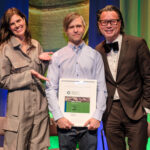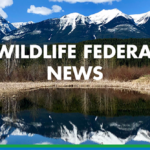A Plentiful Harvest

Conversations about food often include favorite meals and restaurants. But in the Columbia Basin-Boundary food conversations are increasing and evolving, including discussions on local agriculture, food security, and related policies and plans. Food is a hot topic these days, and these conversations include a diversity of people, from farmers to community groups, local governments, and economic development agencies.
Salix and Sedge is one of the many new farms in the region. Farmers Brendan and Cali, pictured here, grow a small quantity of over 40 different crops. Their crops are sold directly to consumers through a Community Supported Agriculture (CSA) service where fresh veggies are provided to CSA members weekly, as well as by sales at the Salmo Farmers market. As new farmers they are constantly educating themselves in as many ways as possible, using resources that range from books to Community Futures Small Business Training, to the Kootenay Local Agricultural Society, to podcasts like Farmer to Farmer. When asked about future plans for their farm they said that while they have some ideas, such as growing their CSA membership, "it's also important to be open to change and flexible around what the needs are in the market and how to best fill those needs". When it comes to running the farm, the challenges vary, from the long term need for continuous improvement in management, gaining efficiencies, and skills development, to the obvious need to make a living.
It can be very difficult to make a living growing food. This is one of the key findings of the RDI's recent Food Systems Project. This project focused on identifying opportunities to sustainably increase food production in the region. The results of this work included: identifying underutilized agricultural land, highlighting resources for food systems planning and action, drawing attention to innovative solutions, looking at climate trends, and more. The RDI is not the only one investigating our regional food system. The recently launched Food Policy Council for the Central Kootenay is another example, as is the identification of agriculture as one of Columbia Basin Trust's strategic priorities.
A RDI poll of Basin residents found an increasing demand for local food, something reflected in the growing number of farmers markets, community gardens, and other initiatives. However, this has not translated into an increased supply. In fact, between the 2001 and 2011 agricultural census there was a 20% decrease in area farmed within the region. The results of the most recent agricultural census are coming in the spring of 2017, which will provide insight into what may have changed.
The collective results of the Food Systems Project suggest that there is not a lack of land suitable for agriculture, nor is there a lack of interested farmers. However, as noted above, financial challenges remain a barrier to farming and land development, and speculation tends to focus on the residential or recreational value, not the agricultural potential. Thankfully there is no shortage of ideas for how to address these challenges as we head forward.
A series of knowledge and research briefs, as well as an inventory of resources and a webinar on advancing the Basin-Boundary regional food system are available on the RDI's regional food systems webpage.
References & Resources
Community Futures Central Kootenay: http://futures.bc.ca/
Central Kootenay Food Policy Council: ckfoodpolicy.ca
Farmer to Farmer Podcast: http://www.farmertofarmerpodcast.com/episodes
Kootenay Local Agricultural Society: http://klasociety.org/
RDI Food Systems Project:http://www.cbrdi.ca/food/
RDI Food Systems Project Webinar: http://www.utube.com/catch?v=Q3qqv9XCP3k&feature=youtu.be
Salix and Sedge Farms: https://www.facebook.com/salixandsedge


























Comments